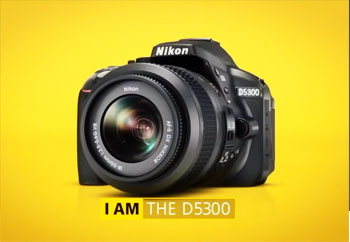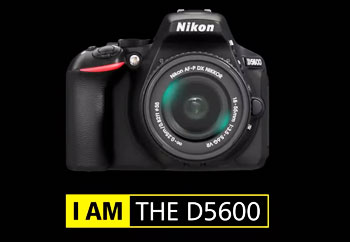The Nikon D5300 and D5600 present an interesting dilemma for photographers looking to buy their first advanced DSLR or upgrade from entry-level models. As successors in Nikon’s 5000 series, the cameras share core features but also showcase meaningful differences.
In this detailed guide, we’ll compare the Nikon D5300 Vs. D5600 across key categories like image quality, performance, video, and design. Read on for an in-depth analysis to help select the right model for your needs and budget.
A Brief Comparison Table
| Feature | Nikon D5300 | Nikon D5600 |
| Sensor Resolution | 24MP APS-C | 24MP APS-C |
| Image Processor | Expeed 4 | Expeed 4 |
| Autofocus System | 39-point, -1 EV sensitivity | 39-point, -1 EV sensitivity |
| Continuous Shooting | 5 fps | 5 fps |
| Video Resolution | 1080p 60fps | 1080p 60fps |
| Rear LCD | 3.2″ articulating touchscreen, 1.04M dots | 3.2″ articulating touchscreen, 1.04M dots |
| Wi-Fi | Yes | Yes |
| Bluetooth | No | Yes |
| Built-in GPS | Yes | No |
| Battery Life | 600 shots | 820 shots |
Nikon D5300 Overview
First, let’s recap the headline specs of the older D5300 model:

- 24MP APS-C CMOS sensor (no optical low-pass filter)
- EXPEED 4 image processor
- 39-point autofocus system
- 5 fps continuous shooting
- 1080/60p video
- 3.2” articulating touchscreen LCD
- Built-in Wi-Fi and GPS
Upon its release in 2014, the D5300 represented a major leap forward for Nikon’s 5000 line. It became the first Nikon DSLR with a flip-out touchscreen and built-in Wi-Fi/GPS.
Nikon D5600 Overview
Now let’s see what changed with the succeeding D5600 released in 2016:
- 24MP APS-C CMOS sensor (no optical low-pass filter)
- EXPEED 4 image processor
- 39-point autofocus system
- 5 fps continuous shooting
- 1080/60p video
- 3.2” articulating touchscreen LCD
- Built-in Wi-Fi and Bluetooth
As you can see, Nikon retained core imaging components between the generations. Changes focused on connectivity. The big upgrade was the addition of Bluetooth for always-on pairing with smart devices.
Also Read: Comparison Between Canon R3 Vs. R6
Key Differences Between Nikon D5300 And D5600
Now let’s dive deeper into how the two cameras compare across key photo and video criteria.
1. Image Quality Comparison
Since they share the same 24MP image sensor and processor, the D5300 and D5600 deliver identical image quality performance:
Resolution
- With 24 megapixels, both provide plenty of resolution for large prints or aggressive cropping. This was a bump up from 16MP on prior models.
Dynamic Range
- 14-bit RAW files allow capturing wide dynamic range. Shadows and highlights retain plenty of detail.
Low Light Performance
- The sensors exhibit impressive noise control even up to relatively high ISO levels. Images stay clean in dim lighting.
Color Rendition
- Nikon’s standard color profile produces natural yet vivid color reproduction. Skies, foliage and skin tones appear excellent.
For pure image quality, the D5300 and D5600 completely match each other. There’s no difference in resolution, noise, dynamic range or color.
2. Autofocus Performance
Another area where the cameras share capabilities is with Nikon’s 39-point Multi-CAM 4800DX phase detect AF system:

- The array covers a wide area of the frame for flexible composition.
- Nine cross-type sensors deliver accurate focus even with fast lenses.
- Sensitive down to -1 EV, the system focuses in extremely low light scenarios.
- Subject tracking helps maintain focus on moving subjects in the frame.
Overall, autofocus performance remains fast and accurate on both models. The AF systems are identical.
3. Continuous Shooting and Buffer
For capturing fleeting moments and action, the D5300 and D5600 offer middling but capable burst speeds:
- Both can shoot full-resolution images at up to 5 frames per second.
- The buffer allows 100 JPEG or 6 RAW shots before filling. Decent but not optimal for extended sequences.
- Write speeds to SD cards allow quick buffer clearing.
For action photography, some photographers may desire faster burst rates. But the 5fps remains sufficient for many needs.
4. Video Recording
In the video department, the D5300 and D5600 have identical capabilities:
- 1080p recording up to 60 fps results in smooth, high-def footage.
- PDAF autofocus provides fast focus transitions and tracking.
- On-board stereo microphones record respectable audio.
- Manual exposure controls offer creative video flexibility.
Overall, both cameras satisfy enthusiasts with sharp high frame rate footage, quality sound, and focus capabilities. But 4K video is now common in this class.
5. Low Light Performance
Low light photography is another area where the shared sensor equates to similar excellent performance:
- In dim indoor scenarios, both cameras deliver clean images even at high ISOs. Noise control is impressive.
- Metering accurately exposes dark scenes. Details in shadows and blacks are maintained.
- AF continues detecting focus in extremely dark environments down to -1 EV.
So for available light shooting, either DSLR will capture stunning nighttime photos and videos with similar quality.
6. Viewfinder and Rear LCD
The user experience between the D5300 and D5600 remains very comparable through the viewfinder and rear LCD:
Viewfinder
- Both feature 0.82x magnification optical pentamirror viewfinders with 95% coverage. Images appear crisp and fluid during composition.
Rear LCD
- Identical 3.2” vari-angle touchscreens offer easy control and visibility from many angles.
- Resolution improved slightly from 1.04M dots on the D5300 to 1.04M dots on the D5600.
Interface
- The intuitive user interface will be familiar to Nikon shooters. Logical menus and dials provide access to settings.
For composing and reviewing shots, either camera delivers an excellent viewing experience with the same articulating display and enhanced touch control.
7. Size and Handling
Ergonomically, the D5300 and D5600 share near identical compact, lightweight bodies:
- The carbon fiber composite material helps keep weight to just 415g.
- Both feature a comfortable grip for stable one-handed shooting.
- Small size makes them easy to pack and carry all day.
For portability and comfort, the sizing stays compact and convenient on both models. There’s no notable handling difference.
Also Read: Comparison Between Nikon Z7 II and Sony A7 IV
8. Wireless Connectivity
One key area where the D5600 upgraded over the D5300 is with wireless:
- The D5300 was Nikon’s first DSLR with built-in Wi-Fi. It enables wireless image transfer and remote control.
- The D5600 adds Bluetooth connectivity for always-on pairing with smart devices. This allows quick automatic transfers.
The D5600’s Bluetooth LE capability gives it the convenience edge for wireless connectivity.
9. GPS Capabilities
Alongside Wi-Fi, the D5300 introduced an internal GPS receiver to geotag photos. This asset was removed from the D5600 likely to extend battery life.
So for built-in location tagging, the D5300 retains the advantage. But Bluetooth makes linking external GPS loggers easy with the D5600.
10. Battery Life
Speaking of battery life, the D5600 shows a noticeable improvement:
- The D5300 is CIPA rated to 600 shots per charge. Not bad but batteries drain faster with heavy use.
- D5600 battery life jumps to 820 photos thanks to revised power optimization.
For extended outings, the D5600 holds the edge in battery longevity.
Also watch this review video:
11. Price Comparison
Being the newer model, the D5600 debuted at a $100 premium over the D5300 retail price. But both offer good value compared to competitors:
- The D5300 launched at $800 body-only or $900 with a kit lens.
- The D5600 originally retailed for $700 body-only or $850 with a lens.
The D5600 cost slightly more upon release. But today both are similarly priced used or refurbished making them great values.
Also Read: Comparison Between Nikon Z7 And Z6 II
Frequently Asked Questions (FAQs)
Below are answers to some common questions buyers have when choosing between the Nikon D5300 and D5600:
The D5600 is the better overall camera compared to the D3500. The D5600 adds a swiveling touchscreen, more AF points, faster frame rate, and Bluetooth/Wi-Fi connectivity. Image quality is the same thanks to the shared 24MP sensor without optical low-pass filter. For just a bit more money, the D5600 is significantly more capable.
The next tier camera above the D5600 in Nikon’s lineup is the D7500. It offers a faster 8fps burst, better AF system, deeper buffer, and additional weather sealing. The D7500 appeals to enthusiasts and pros needing more performance. But at a higher price, the D5600 remains an extremely capable mid-range DSLR.
Utilize the D5300’s articulating rear LCD to compose more creative shots from high or low angles. Enable Active D-Lighting to balance shadows and highlights in contrasty scenes. Use AF Fine Tune to calibrate lenses for tack sharp focus. In low light, shoot at medium ISOs like 640 or 1250 for the best balance of noise control and detail. Take advantage of built-in interval shooting for easily creating timelapses.
Some standout benefits of the D5300 include superb 24MP image quality thanks to the sensor lacking an AA filter, fast Expeed 4 processor for 5fps bursts, advanced 39-point AF, an articulating touchscreen LCD, and built-in Wi-Fi/GPS connectivity for easy wireless transfers and geotagging. It’s a fantastic mid-range DSLR.
Also Read: Comparison Between Nikon Z7 II And Sony A7R IV
Final Thought
For most photographers debating between these mid-range Nikon DSLRs, the D5600 makes the most sense:
- It retains all the same great photo abilities of the D5300 while adding Bluetooth and improving battery life.
- Unless you need built-in GPS, the D5600’s wireless connectivity perks provide better real-world utility.
- Since both models share the same sensor, image quality remains identical.
However, the D5300 still stands out for its GPS integration. For applications like travel photography where automatic geotagging helps, the D5300 may justify choosing the older model.
But for most people, the D5600 gives you everything great about the D5300 and throws in some nice evolutionary bonuses like Bluetooth and extended battery life.
